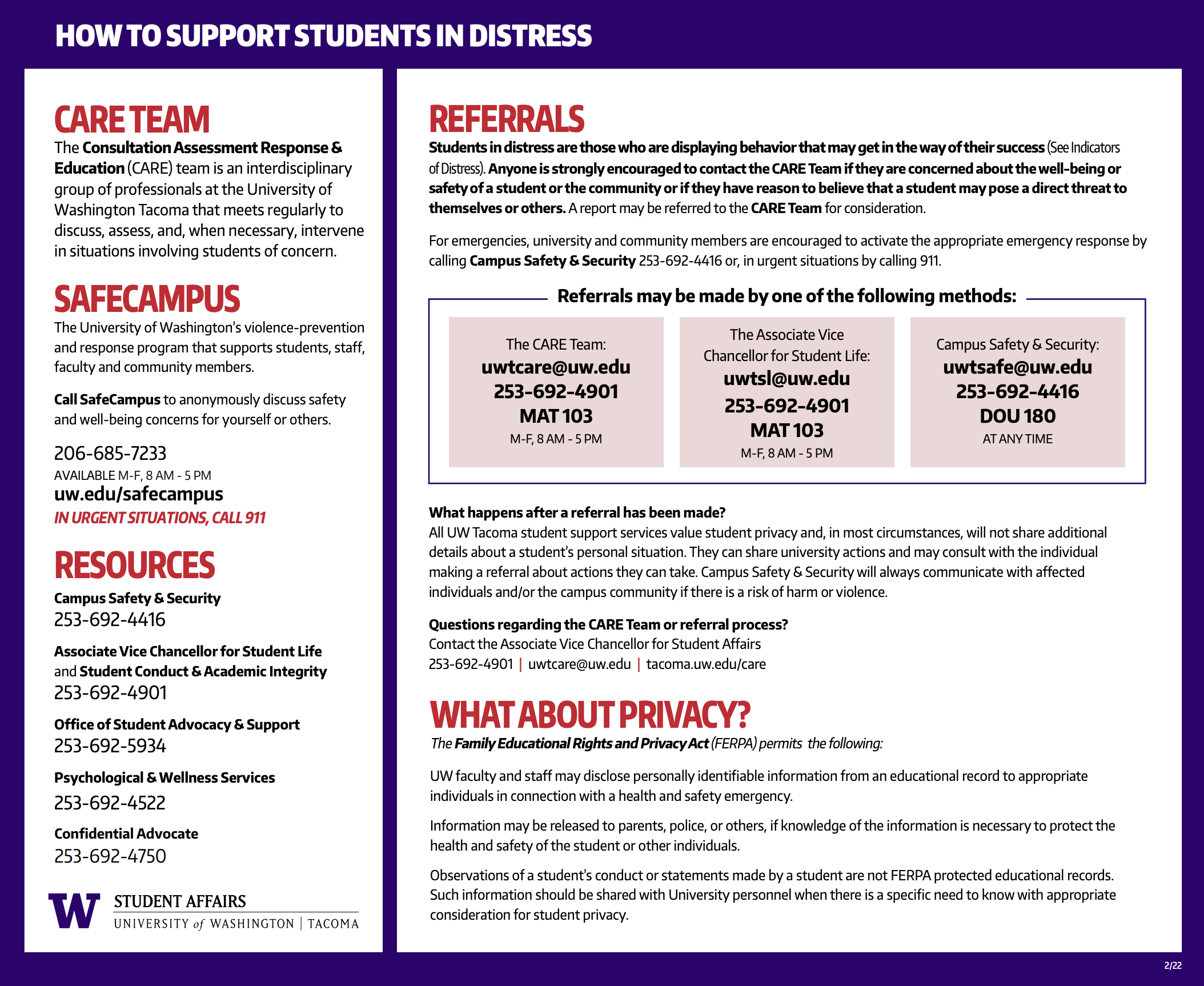Main Content
Guide for Supporting Students in Distress: Purple Sheet
Student Life has compiled what is referred to as the "Purple Sheet." This document serves as a quick reference to assist faculty and staff in assessing behaviors that may be referred to the CARE team and how to do so with a step by step guide.
For imminent threats, please contact 911 immediately.

CARE Team
The Consultation Assessment Response Education (CARE) team is an interdisciplinary group of professionals at the University of Washington Tacoma that meets regularly to discuss, assess, and, when necessary, intervene in situations involving students of concern and in distress.
See Something?
Be aware of the following indicators of distress. Look for groupings, duration, and severity - not just isolated symptoms. What to look for:
Academic
- Sudden decline in quality of work and grades
- Repeated absences
- Disorganized performance
- Multiple requests for extensions
- Overly demanding of faculty and staff time and attention
- Bizarre content in writings or presentations
- Focus of office hours/ meetings is more personal concerns than academic
Psychological
- Self-disclosure of personal distress such as family problems, financial difficulties, contemplating suicide, grief
- Unusual/disproportional emotion response to events
- Excessive tearfulness, panic reactions
- Delusions and paranoia
- Irritability or unusual apathy
- Verbal abuse (e.g. taunting, badgering, intimidation)
- Expressions of concern about the student by their peers
Physical
- Marked changes in physical appearance including deterioration in grooming, hygiene, or weight loss/gain
- Excessive fatigue/sleep disturbance
- Intoxication, hangovers, or smelling of alcohol
- Disoriented or “out of it”
- Garbled, tangential, disconnected, or slurred speech
- Behavior is out of context or bizarre
Safety Risk (Seek help immediately)
- Implying or making a direct threat to harm self or others
- Unprovoked anger or hostility
- Physical violence (shoving, grabbing, assault, use of weapons)
- Academic assignments dominated by themes of extreme hopelessness, rage, worthlessness, isolation, suicidal ideations/violent behavior - a “cry for help”
- Stalking or harassing behaviors
- Communicating threats via email, correspondence, texting, or phone calls
Do Something
1. Manage the Situation
The welfare of the campus community is the top priority when a student displays threatening or potentially violent behavior. Seek help immediately.
2. Listen Sensitively and Carefully
Use a non-confrontational approach and a calm voice. “I’m worried about you.”
3. Be Direct
Don’t be afraid to ask students directly if they are under the influence of drugs or alcohol, feeling confused, or having thoughts of harming themselves of others. “Have you been feeling bad enough to consider hurting or killing yourself?”
4. Connect to Resources
Offer alternatives and assist the student in choosing the best resource.
5. Follow Through
Direct the student to the physical location of the identified resource. Follow up with the student and involved parties.
6. Consultation and Documentation
Document your interactions with distressed students and consult with your Principal Administrator/department chair/supervisor after any incident.
